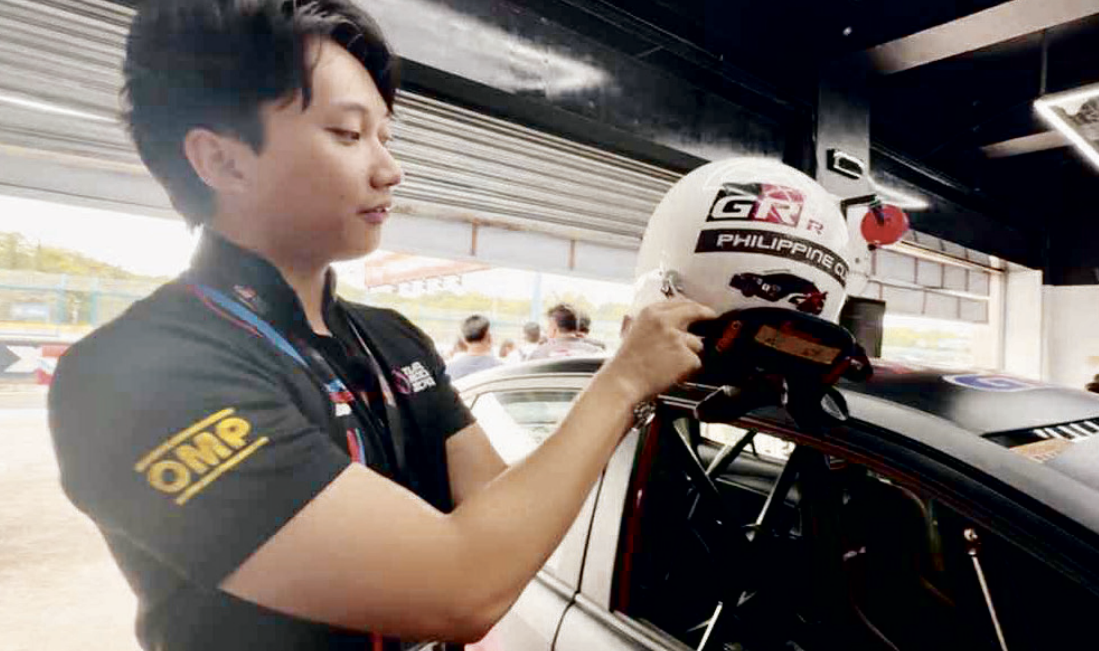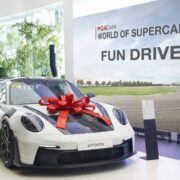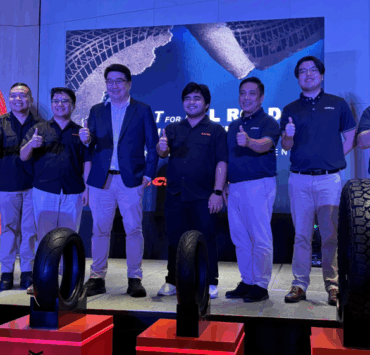An intense wheel-to-wheel race where everyone goes home in one piece

A car is replaceable. But a human life is not. For every motor racing event, this mantra is tested to its very limits. On one end, race teams must apply everything they know about physics, car engineering and design to make their vehicles run faster and lighter, and handle better. On the other end, safety teams must also apply everything they know about physics, car engineering and design, AND human physiology in order to keep the human occupants alive and well all throughout the race.
That’s why the job of people like Arthur Tuason III of Tuason Racing is critically important not only during race day, but in the months, weeks, and days leading up to it.
Arthur, the son of Tuason Racing founder JP Tuason, found the time in his very busy schedule to take me on a walk-through of the safety features of the racing cars of Toyota Gazoo Racing Philippine Cup during the final race weekend on Aug. 9 at the Clark International Speedway.
The young man was visibly proud of the fact that, throughout all the racing seasons of the TGR Philippine Cup since it began in 2014 as the Vios Cup, there hasn’t been a single fatality nor a serious injury involving the drivers and the pit crews.
Fender benders, wrecked panels, busted engines and trannies, even cars totaled because of rollovers and crashes with each other and collisions with barriers—we’ve seen it all happen during the TGR Philippine Cup races, but what truly matters is that the drivers have walked away from all these virtually unscathed.
Arthur credits this safety record to the professionalism and discipline that TGR Philippine Cup partner Tuason Racing has helped instill among all race participants, and the fact that all racing drivers are firmly harnessed into their seats, wear specialized helmets and suits, and are protected from all sides by roll cages.
And yes, even the car crashes, breakdowns, and collisions involving the Vios racing cars in this one-make race series serves a purpose for Toyota Motor Philippines, as this allows the carmaker’s research and development groups to further improve upon the vehicle’s performance, handling, and safety in real-world, normal use—a practice very much aligned with its philosophy of “driving, breaking, and fixing” integral to the company’s vehicle development programs.
Arthur says that injuries still occur among race drivers, but nothing of the sort that would keep them away from their next races.
“It’s a high-speed sport, there will always be injuries, but thankfully there never have been major injuries. All of our drivers who have rolled over, crashed, or completely totaled their car, have returned to racing. A lot of them basically walked out even if their car flipped over,” he quipped.
Life-saving tubular frame
Arthur explains that the Vios racing cars used at the TGR Philippine Cup don’t become race-ready right away.
“With the CVT model, we barely make changes. It’s basically a stock car, but it has the capability to become a race car. But it doesn’t become a race car overnight. That’s why we include a conversion kit,” he points out.
He explained that the conversion kits make “an already safe car into a very hardy race car that can withstand any kind of damage. It’s a fighting vehicle. This car can take it, all because of the roll cage.”
Pointing to the tubular steel framework placed around the car’s interior, Arthur said, “Modern cars are actually built to have crumple zones in order to disperse force. The roll cage will keep the car’s internal structure around the driver stable and intact.”
In other words, the rest of the car may fall apart or crumple like an accordion in severe crashes, but the driver’s compartment will stay whole, thanks to the roll cage.
In a racing car, all other seats other than the driver’s are also removed, primarily to make the car lighter.
Roll cages aren’t the only safety features of the Vios racing car. A bucket seat, provided by Italian maker OMP, keeps the driver firmly in place or “very snug” in order to prevent drivers from being jostled around too much in a car, especially during a collision or crash.
Complementing the bucket seat is the 5-point seatbelt, which keeps the driver in place and keeps their body from smashing into the steering column during high-speed collisions. And unlike conventional 3-point seatbelts, 5-point seatbelts spread the immense forces of a collision over the strongest parts of the driver’s body.
And mind you, it’s not strapped onto the racer for comfort, but for his dear life. “It’s almost like a straitjacket with how tight it is,” Arthur said.
Inside the car, there is a fire extinguisher that the driver can easily get access to, “so the drivers can put out the fire themselves if need be,” he said.

HANS device
And yes, race car drivers can’t leave home without it—the all-important helmet. Arthur showed an FIA homologation helmet that he said follows international crash and fire safety standards. Attached to the helmet is the HANS device. HANS stands for “head and neck support.”
“This isn’t part of the helmet, but works with it,” Arthur clarified, showing me the device. “It’s a yoke that sits on the driver’s shoulders, held down firmly by the 5-point seatbelts. These straps,” he said, pointing to tethers on the device, “clip onto the helmet. This prevents the driver’s head from snapping forward in a crash, which is what causes whiplash or more severe neck injuries. The range of movement becomes very limited.”
With all these safety features on the cars and on the drivers, Arthur stressed, “We are basically world-class racing here in the Philippines.”
Emergency response vehicles
Arthur added that there are “a lot of prepared procedures” in terms of emergency response. He went on to describe that the safety car is not just there to prepare the pack for the race to start but is also there in case of an emergency, with the race director sending out the safety car that will control the pack behind it.
“All racers know the procedure that when the safety car is out, they must follow the safety car. The safety car is there to set the pace,” he said.
Following that, there is also the medical car with a fully certified medical doctor “that can respond quickly” to any type of emergency.
There are also two ambulances on standby. If an incident transpires that requires an ambulance, another ambulance remains on standby so that the race can continue. A quick-response vehicle as well as a tow truck from the Automobile Association Philippines is on hand.
“Usually there are four vehicles. They’re basically there to pull out disabled vehicles from the race track. The response time is very fast. We’re happy to have a very focused and a very aggressive race director,” Arthur disclosed.
At the end of the day, regardless of how many race vehicles go out of commission during the heat of the battles, Arthur calls it just in a day’s work when he announces that all racers and crews get to see action again next season.





















